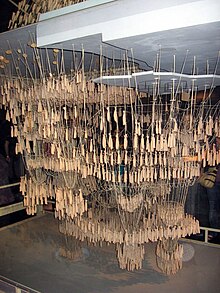Hanging model
Hanging models are (predominantly) architectural models hung upside down on strings or chains. They can be used to plan the supporting structures of buildings. Until the introduction of computer models, this was a common method to e.g. B. to model membrane structures .
principle
When constructing large structures, it is important that the structure is only subjected to pressure. Bending moments are to be avoided, as stone structures cannot absorb them. The aim of corresponding static planning is therefore to construct a model that meets these requirements.
The hanging model is based on the principle of reversing the chain line (also called catenoids ). A chain line takes on a stable form when only tensile forces act, as a chain or cord is not resistant to bending . For a hanging model, the structure of a model is built up from cords or chains and hung upside down. Because the cords are limp, no bending moment can act in them. The only forces acting on the model hanging upside down are tensile forces. The model differs from the later building only in the direction of the load. The tensile loads become compressive loads here, but the structure of the building is not subjected to bending . When the model is reversed, the tension-loaded chain lines become pressure-loaded support lines .
From a static point of view, an arch made of stones of equal width is optimally formed when it forms a chain line. Models turned upside down result in a chain line that can then be used as a draft for a sheet that is purely pressure-stressed. Due to the principle of the hanging model, complicated shapes can be realized without complex calculations with a minimum of material.

Vaults that are designed on the principle of an upside-down chain line are also known as the Catalan vault . Mathematically, they can be described by a hyperbolic paraboloid (see also hyperbolic paraboloid ).
historical development
The principle has been documented by drawings since around 1700, but has been forgotten again. The principle was only rediscovered by the Catalan architect Antoni Gaudí . It is unclear whether the hanging model was used to plan Gothic cathedrals in the Middle Ages.
There is written evidence that the Italian mathematician and engineer Giovanni Poleni (1683–1761) used hanging models. In 1743, Polini was commissioned by Pope Benedict XIV to investigate damage to the dome of St. Peter's Basilica . To do this, he built simple hanging models that consisted of chains loaded with weights. The Baden architect Heinrich Hübsch (1795–1863) also used hanging models to plan the vaults of his buildings. He attached strings to upside-down sectional drawings in order to optimize them. Based on this principle, he built the Church of St. Cyriakus in Bulach near Karlsruhe (1834–1837).
The following builders and architects used the principle of the hanging models:
- Giovanni Poleni (1683–1761)
- Carl Anton Henschel (1780–1861)
- Heinrich Hübsch (1795–1863)
- Antoni Gaudí (1852-1926)
- Karl Mohrmann (1857–1927)
Applications by Antoni Gaudí
The technique of the hanging models is inextricably linked with the Catalan architect Antoni Gaudí . He revived this old technique, refined it and used it in the planning of many of his buildings.
Gaudí's intensive and pioneering preoccupation with problems of static optimization led to the use of a hanging model in the design for the church of Colonia Güell. Gaudi began with his designs for the church of Colònia Güell from 1898. It was not until 1908 that a hanging model was created on a scale of 1:10 and a weight of 1: 10,000. The hanging model consisted of threads that were pulled into a stable net configuration with sacks filled with shot. The walls or the domes were represented in the model by parallel or radial threads.
The basic techniques that Gaudí developed were used to help him design the Sagrada Família . However, he later switched mainly to graphic methods.
literature
- R. Graefe, J. Tomlow, A. Walz: A lost model and its reconstruction. In: Bauwelt 15/1983, pp. 568–573.
- J. Tomlow: The model - Antoni Gaudí's hanging model and its reconstruction - New insights into the design for the church of Colonia Güell. (Dissertation), Communications from the Institute for Lightweight Structures (IL), Vol. 34, Stuttgart 1989.
- J. Tomlow: The spirit of calculation in the architectural work of Antoni Gaudí. In: Gaudí 2002 Miscellany. Edición conmemorativo del Año Internacional Gaudí. Instituto de Cultura de Barcelona. Barcelona 2002, pp. 176-199.
- J. Tomlow: La evolución de la innovación estructural de Gaudí - Los proyectos de la sede de la Misión Franciscana, la iglesia de la Colonia Güell y el templo de la Sagrada Familia. In: OP Ingeniería y Territorio, N ° 59, tercer época 2002, pp. 48–57.
Individual evidence
- ↑ Alexander Frederic Walser: Form finding of bowls with numerical hanging models. Diploma thesis University of Stuttgart; (2011) Finding the shape of bowls with numerical hanging models ( Memento from April 7, 2014 in the Internet Archive ).
- ↑ Wolfram Jäger , Tammam Bakeer, Alexander Peinelt: Suspended models - Form -finding for buildings based on physical and digital models ; Technical University of Dresden ; Archive link ( Memento of the original from April 7, 2014 in the Internet Archive ) Info: The archive link was inserted automatically and has not yet been checked. Please check the original and archive link according to the instructions and then remove this notice.
- ^ Johanna Stiegler: Chain lines based on the Colonia Güell Church by Antoni Gaudi. Annual work Freiherr-vom-Stein-Schule Hessisch Lichtenau, 2012; [1]
- ↑ R. Graefe: For the shaping of arches and vaults. Journal for the History of Architecture 1986, pp. 50–67


